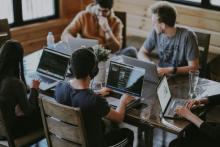Name: Goli Samimi
Current position: Group Leader, Ovarian Cancer Group, Garvan Institute of Medical Research
Location: Sydney, Australia
Time in current position: ~1 year
Postdoc: Tumor microenvironment effects in ovarian cancer with Michael J. Birrer, NCI
My job: I am the group leader of the Ovarian Cancer Group at a medical research institute called the Garvan Institute. I have a joint appointment at the University of New South Wales. So I have grad students from the university and postdocs working in my group. It’s different not being on the bench—my typical day is writing. Lots of writing and lots of meetings. I’m either writing papers, protocols, grants, fellowships or grant reviews. Lots of emails. Typical for what you’d expect for a junior investigator. The hardest part is that I tend to organize my schedule for the week and it’s always thrown off, so I have to get used to not necessarily completing everything I had set out for the week. A necessary skill for sure in this kind of position is time management! Also writing and presentation skills.
My story: I joined the Cancer Prevention Fellowship Program at NCI after completing my Ph.D. at the University of California, San Diego. This is a fantastic program that provides the opportunity for postdoc fellows to spend year one of their training obtaining an M.P.H. I received mine from Harvard School of Public Health in 2006 and then began my research at NCI. I always planned to stay in academia, as I find that the environment stimulates both the investigators and the trainees. I expected to work at a cancer center affiliated with a hospital and a university. When the time came to search for jobs, I only applied for academic positions, and mainly at R1 universities. When I got a bit nervous about my lack of prospects, I also applied to smaller teaching universities. But after visiting one, I realized it wasn’t exactly the type of research environment I was interested in.
Network, network, network: I made sure that everyone I knew was aware that I was looking for a job. Basically, when I found a job I really wanted, I checked with my contacts to see if any of them knew anyone in the department. Interestingly, the two big positions I was offered in the States were not advertised positions but instead came about from my networking at AACR, which is a big annual meeting for cancer researchers.
Read more about the ups and downs of life Down Under.
Challenges along the way: I did not get many interviews or offers. I was particularly picky about where I wanted to live (only on the west coast, or the northeast), so I think competition was a big issue. Also, I didn’t have many papers from my postdoc fellowship, which obviously hurt me as well. But I did have a good publication record from my Ph.D. and M.P.H. And although I wasn’t able to use it internationally, I assume that my K99/R00 grant helped impress the department [at Garvan] that I was able to get funded. I have also always been involved in committee work, which I think looks good, as new faculty members are expected to serve on committees.
How I got my job: The position was posted in naturejobs, and it was exactly what I was looking for. It focused on ovarian cancer in an institute that had a strong reputation, great facilities and is extremely collaborative. It was also a unique (and beneficial) situation in that I was taking over for a different leader who had left, so the research group was already present and productive—one postdoc, one grad student and a research assistant. I also brought on another postdoc when I arrived.
My interview experience was fantastic, but I think I was lucky in that the program was relatively certain they wanted me so it didn’t feel like an interview so much as a visit. They were mainly concerned with my commitment to making a big move.
The upside: I feel really fortunate that I look forward to coming to work every day. There is much more camaraderie, collaboration and support than I’ve seen in the States. I was also really lucky coming into a group that was already in existence, as the researchers are all quite independent and can get the work done without hand-holding.
Trade-offs: The system here is that everyone, including the department heads, is on five-year renewal contracts. There is no tenure, so the pressure to produce and get funding is quite high, as it is in the States. Obviously, the biggest compromise is living so far away, but it’s been fine to deal with so far.
A smooth transition: The main adjustment to moving to Australia was dealing with the cost of living. But my institute was extremely supportive about giving me time to find a good place to live. They also made the transition quite easy in that they hired lawyers to deal with visa issues, so all I had to deal with was signing paperwork and waiting. The hardest part was leaving my colleagues in my fellowship program, as they were great friends and scientists who always knew how to provide help and guidance and always supported my work.
I absolutely love living in Sydney. It’s much slower-paced, and everyone is extremely friendly and fun. It’s been great to be back at the beach (I’ve even started taking surfing lessons). Of course I miss my friends and family, but I make it back to the states two or three times a year, so between those visits and Facebook/email/Skype, we’ve kept in touch quite well.
What’s next: At this point, I am focusing on finishing up some loose ends on projects for quick papers. I am also working on getting funded so that I can commit my research group to another three to five years.
I’m doing exactly what I want to do now. I prefer to write and think and explore the science without the technical aspect. Luckily, my team is very meticulous and pays great attention to detail so it works out very well. This is my dream job. As long as they will have me, I would like to stay.
Goli can be contacted through the OITE alumni database.
NIH Alumni: Where are they now? Profile 10 – Group Leader, University of New South Wales
Categories
Alumni Spotlight




